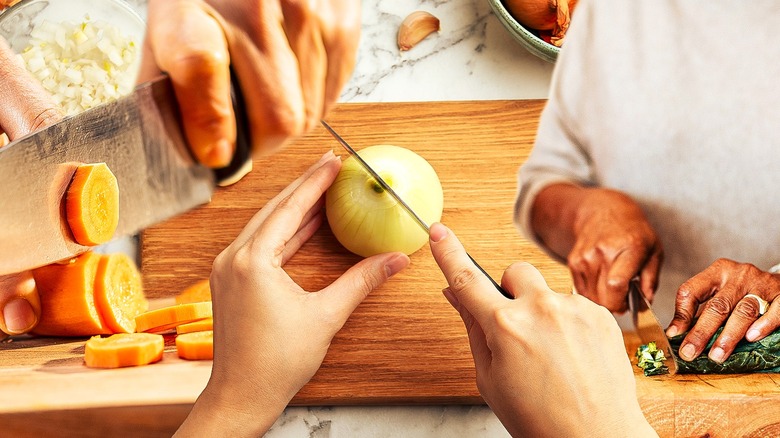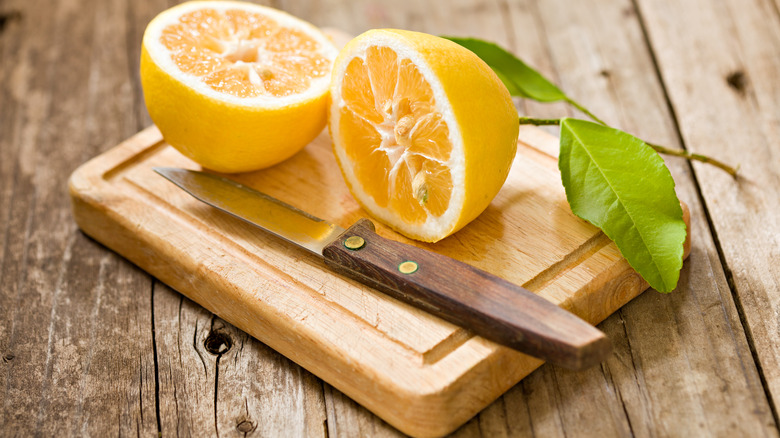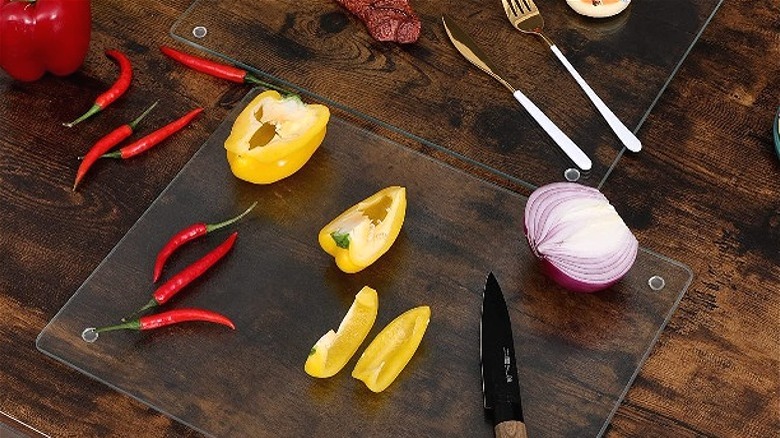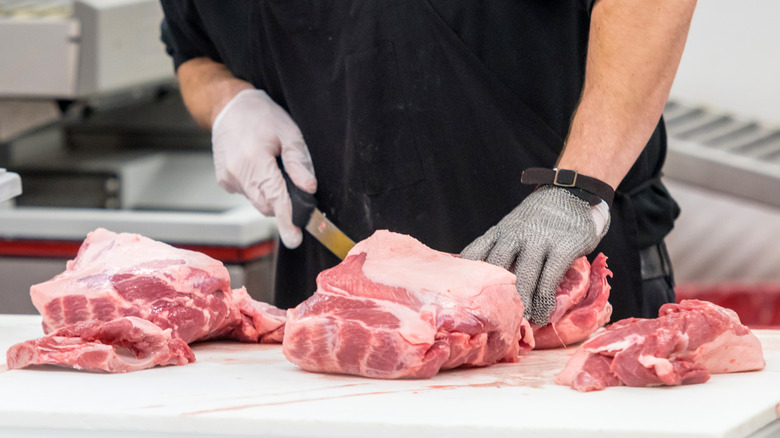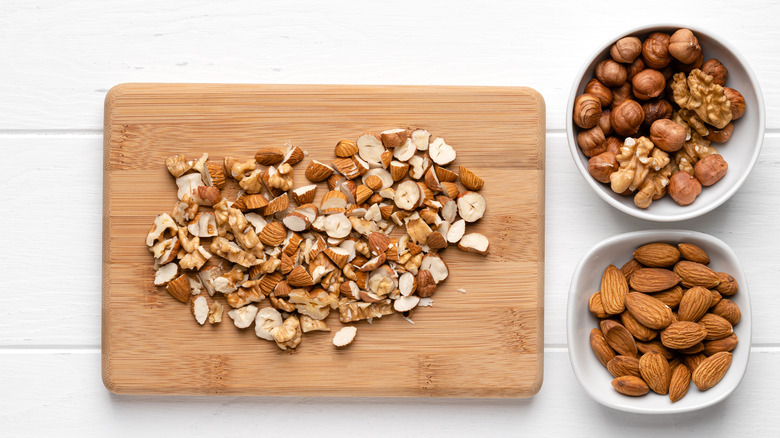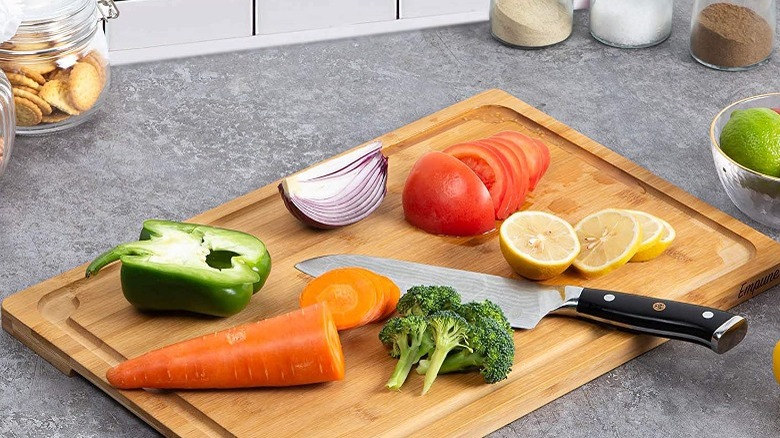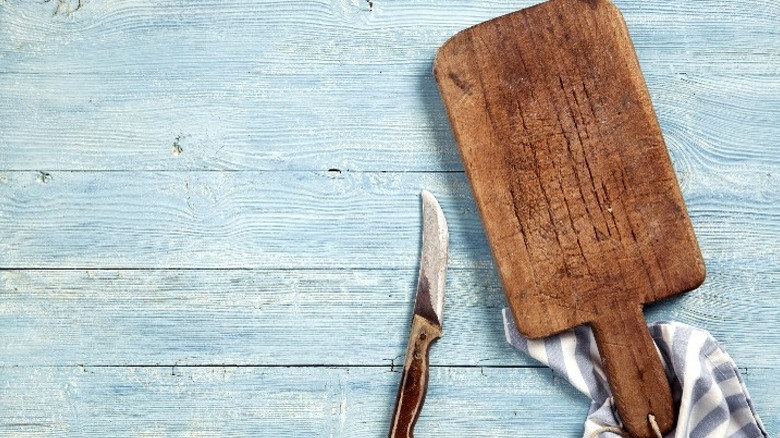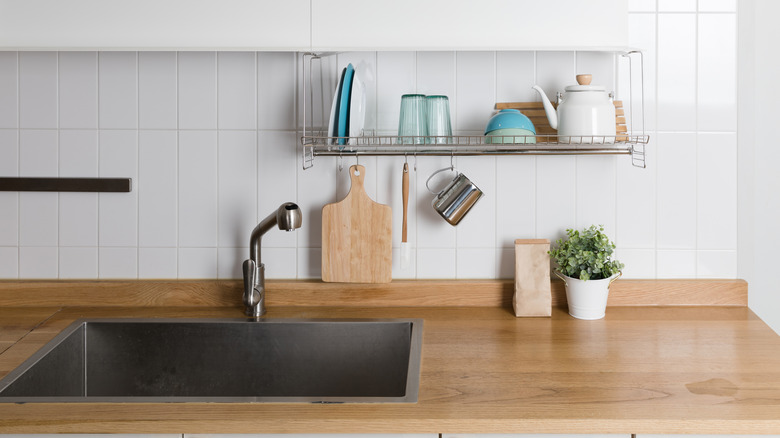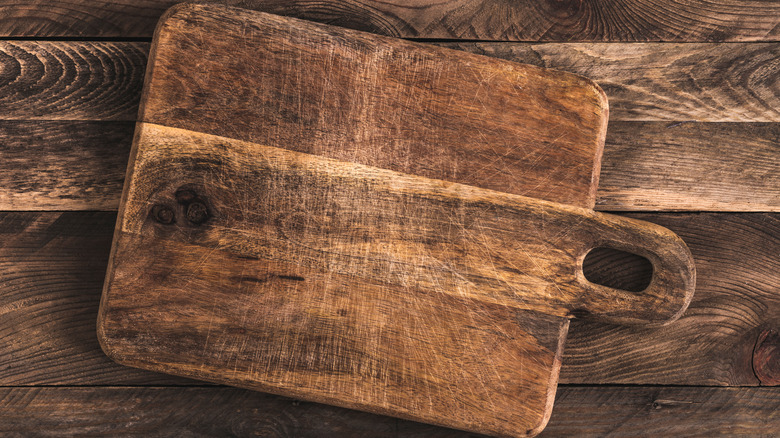10 Cutting Board Mistakes You May Not Realize You're Making
Our cutting boards get a lot of use. From chopping vegetables to slicing bread to cutting meat, chances are you're using your kitchen cutting board on an almost daily basis. What you might not realize is that you've likely been making some mistakes when using your cutting boards in the kitchen. Unfortunately, some of these mistakes can have pretty dire consequences. These can include ruining your cutting board, decreasing the overall lifespan of your cutting board, leaving yourself with a big mess to clean up, dulling your knives, or even potentially making yourself or others in your home sick.
If you've been assuming that cutting boards are such a basic kitchen tool that no one could possibly make a mistake while using them, then you'll want to keep reading. We're going to explore some of the common mistakes people make with them. We'll also help you understand how to avoid these mistakes and what you should do instead.
1. Using a cutting board that's too small
Trying to make do with a cutting board that isn't large enough for the cutting task at hand is not a good idea. If the surface of the board isn't big enough, the food you cut is going to be much more likely to slide off onto your counters, or even onto the floor. This will just end up making more of a mess for you to clean up once you've finished chopping. Plus, if you're cutting something like raw meat, you're risking contaminating more surfaces in your kitchen and making the cleanup process all the more involved.
Using a cutting board that is too small can also make it more likely for you to injure yourself while slicing or chopping. If you're trying to move your knife around in a tighter space, you may inadvertently slice one of your fingers. A bigger cutting board won't take up that much more space in your cabinets or your dishwasher, but it will be much safer and easier to work with.
2. Putting wooden cutting boards in the dishwasher
If you have wooden or bamboo cutting boards, how do you clean them? If you answered, "in the dishwasher," then you've been making a big mistake. Washing a wooden cutting board in the dishwasher exposes it to excessive levels of moisture and heat, neither of which are good for the wood. As the board is exposed to heat and humidity, it may crack or warp. Beyond the negative impact on the board's appearance and how easy it will be to use, cutting boards with cracks can also be dangerous. Those tiny cracks can offer the ideal environment for bacteria to grow and multiply, making it more likely that what you put on the board will become contaminated.
Instead of cleaning your wooden cutting boards in the dishwasher, you should always hand-wash them. Use hot water and soap and thoroughly scrub the board. Then, let it dry before putting it away.
3. Using a glass cutting board
Cutting boards may be made of wood, bamboo, plastic (typically high-density polyethylene), or glass. While most of these materials are all good options when stocking your kitchen, there is one that you'll be making a mistake if you choose: glass. Glass cutting boards can actually make cooking in the kitchen less safe. They're slippery when wet, which means they could slide around when you're trying to work. This could make it more likely for you to accidentally cut yourself. If a glass cutting board gets dropped, slides off of the counter, or is bumped the wrong way with a heavy tool, it may also shatter.
Another reason to stay away from glass cutting boards is that they can dull knives. Each time you run a knife against the surface of the board — as you would do when cutting or slicing — it will slowly chip away at the blade of the knife. After repeated use, your knives will be much less sharp. Dull knives are obviously less effective when cutting food, but they are also less safe to use.
4. Not having a cutting board dedicated to raw meat
Even if you wash your cutting board after using it for raw meat, there could still be traces of bacteria or viruses on the board. The next time you use that cutting board for vegetables, bread, or other foods, you're running the risk of cross-contamination. The safest choice is to have a separate cutting board that is only used for raw meat, seafood, and poultry. This way, you eliminate the chance of cross-contamination and getting food poisoning from traces of bacteria left behind on the board.
To help you remember which board is for meats and which is for other items, it may be a good idea to look at purchasing some colored cutting boards. Remembering that the red cutting board is for raw meats, for example, will be much easier than distinguishing between two cutting boards that look nearly identical.
5. Cutting allergens on the same board as other items
Bacteria from raw meat isn't the only example of cross-contamination that can be harmful in the kitchen. If anyone in your home suffers from allergies, the way you use your cutting boards could be putting them at risk. For example, imagine that someone in your home is allergic to peanuts. If you chop peanuts on your cutting board, there could still be traces of the nuts left after cleaning the board. When you later use the board to cut food that the person with allergies will be using, the nut traces could transfer to the food item they're eating. As you can guess, this can increase the chances of them having an allergic reaction.
Just as you should use a separate cutting board for raw meats, you should also have a separate cutting board to use for any allergens of the other people in your home. This will help significantly decrease the chances of allergens coming into contact with foods they'll be eating. Having a colored cutting board can help with this as well.
6. Not using a cutting board with wells
Have you ever cut a watermelon or beef roast on a cutting board — even a large one — only to have the juices run off the board and onto your counters or floors? There is a solution to this problem. Invest in a large cutting board with a juice well. These boards are specifically designed to catch the juices and drippings from fruits, meats, and other items. Rather than ending up on your countertops, the liquids will be contained in the cutting board so that you can simply dump them into the sink once you've finished cutting.
You can find wooden, bamboo, and high-density polyethylene cutting boards with juice wells, so you won't even need to compromise on your preferred material. Some cutting boards even have a reversible design, where one side is completely flat and the other has a well around the perimeter. If you're looking to use one board for the majority of your cutting tasks (aside from those involving raw meat or allergens), a reversible board may be a good choice.
7. Continuing to use cutting boards with deep grooves
Even the best cutting boards will not last forever. Another cutting board mistake many people make is not realizing when it's time to say goodbye to an old cutting board and replace it with a new one. If you're still using an old cutting board that has deep grooves from knives, it's time to get rid of it. Bacteria can get trapped in these grooves and then transfer into the foods you're cutting. This may put you or others at risk of food poisoning. Unfortunately, even when you clean the cutting board, some of the bacteria will still remain.
The safest option is to get rid of the old board and purchase a new one. It just isn't worth taking the risk of making someone sick. Moreover, a new cutting board will look nicer in your kitchen and will be easier to work on.
8. Not seasoning a wooden cutting board
Seasoning wooden cutting boards is an important step you shouldn't skip. Unseasoned boards will absorb juices from the meats and other items when you're cutting them. Not only can this make the cutting board smell over time, but it can also change color in certain areas where the juices are absorbed. By absorbing more liquids, the cutting board may also retain too much moisture. This can make the wood warp, crack, or even rot.
Seasoning can protect wooden cutting boards from all of these potential problems. This cutting board step involves pouring some food-safe mineral oil on it and rubbing it into the wood. Next, let the cutting board rest and absorb the oil for a few minutes. You should re-season wooden cutting boards about once a month. When you get a new cutting board, you may want to repeat the seasoning process a few times in a row to really make sure the cutting board is ready for use.
9. Putting your cutting board away before it's dry
Ready to discover yet another cutting board mistake you could be making? After you clean your cutting board — either by hand-washing it or cleaning it in the dishwasher — do you put it right into your cabinet? While you may think that putting the cutting board away and keeping your kitchen counters clear is best, that is actually not the case.
When you put a cutting board away before it is completely dry, you're increasing the chances of more bacteria being able to grow on it. Bacteria thrive in damp conditions, and the cutting board won't finish drying as quickly in a cool and dark cabinet as it will when out in the dish drain. Always wipe your cutting boards down with a dry dish towel to remove excess water, and then wait to put them away until they are fully dry.
10. Not sanitizing cutting boards when needed
With all the previous information about how bacteria can grow on a cutting board, you probably already understand the importance of washing these kitchen tools after each use. However, did you know that a standard wash won't always be sufficient? When your cutting boards come into contact with raw meat, they will also need to be sanitized. This is particularly true with wooden cutting boards that will absorb more of the bacteria, but it is also a good practice to follow with plastic boards to keep everyone healthy.
Fortunately, sanitizing a cutting board is not complicated. All you'll need is a little bit of bleach and some water. Add one gallon of water to your kitchen sink (with the stopper down). Then, pour in one tablespoon of chlorine bleach. Soak your cutting board in the diluted bleach solution for about three minutes. This will be enough time for the bleach to kill any bacteria that are present on the board. After the board has finished soaking, drain the water, and rinse it off. Wash it again using hot water and dish soap to be sure that all of the bleach and its corresponding odor have been cleared off. After rinsing the soapy water off of the board, pat it dry with a dishcloth and leave it out to dry.
